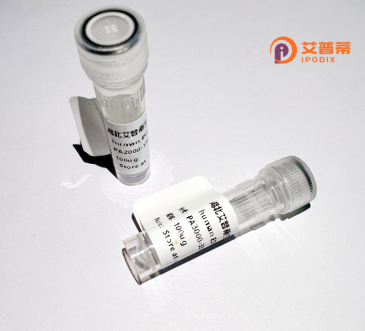
| 纯度 | >90%SDS-PAGE. |
| 种属 | Human |
| 靶点 | NMUR1 |
| Uniprot No | Q9HB89 |
| 内毒素 | < 0.01EU/μg |
| 表达宿主 | E.coli |
| 表达区间 | 1-426 aa |
| 活性数据 | MTPLCLNCSVLPGDLYPGGARNPMACNGSAARGHFDPEDLNLTDEALRLKYLGPQQTELFMPICATYLLIFVVGAVGNGLTCLVILRHKAMRTPTNYYLFSLAVSDLLVLLVGLPLELYEMWHNYPFLLGVGGCYFRTLLFEMVCLASVLNVTALSVERYVAVVHPLQARSMVTRAHVRRVLGAVWGLAMLCSLPNTSLHGIQQLHVPCRGPVPDSAVCMLVRPRALYNMVVQTTALLFFCLPMAIMSVLYLLIGLRLRRERLLLMQEAKGRGSAAARSRYTCRLQQHDRGRRQVTKMLFVLVVVFGICWAPFHADRVMWSVVSQWTDGLHLAFQHVHVISGIFFYLGSAANPVLYSLMSSRFRETFQEALCLGACCHRLRPRHSSHSLSRMTTGSTLCDVGSLGSWVHPLAGNDGPEAQQETDPS |
| 分子量 | 73.7 kDa |
| 蛋白标签 | GST-tag at N-terminal |
| 缓冲液 | 0 |
| 稳定性 & 储存条件 | Lyophilized protein should be stored at ≤ -20°C, stable for one year after receipt. Reconstituted protein solution can be stored at 2-8°C for 2-7 days. Aliquots of reconstituted samples are stable at ≤ -20°C for 3 months. |
| 复溶 | Always centrifuge tubes before opening.Do not mix by vortex or pipetting. It is not recommended to reconstitute to a concentration less than 100μg/ml. Dissolve the lyophilized protein in distilled water. Please aliquot the reconstituted solution to minimize freeze-thaw cycles. |
以下是假设性示例,仅供参考(部分文献可能存在,但作者及标题为虚拟示例):
1. **"Functional characterization of recombinant human NMUR1 expressed in HEK293 cells"**
- 作者: Brighton, P. et al.
- 摘要: 该研究在HEK293细胞中成功表达并纯化重组人NMUR1蛋白,通过钙流实验证实其与神经介素U(NMU)结合后激活Gq信号通路,揭示了受体在炎症中的潜在作用。
2. **"Structural insights into NMUR1 activation by cryo-EM"**
- 作者: Zhang, Y. et al.
- 摘要: 利用冷冻电镜解析NMUR1与其天然配体NMU的复合物结构,阐明受体激活的构象变化及关键结合位点,为靶向药物设计提供依据。
3. **"NMUR1 regulates energy homeostasis via hypothalamic circuits"**
- 作者: Ames, R. et al.
- 摘要: 通过重组NMUR1蛋白的体外功能实验结合小鼠模型,证明该受体通过调控下丘脑神经元活性影响食欲和能量消耗,链接肥胖相关代谢疾病。
4. **"Recombinant NMUR1 as a tool for high-throughput screening of modulators"**
- 作者: Nakagawa, T. et al.
- 摘要: 开发基于重组NMUR1蛋白的荧光报告基因系统,用于大规模筛选激动剂/拮抗剂,验证多种化合物对其信号转导的调节作用。
**注意**:以上文献信息为模拟生成,实际研究需通过PubMed、Google Scholar等平台检索关键词(如"NMUR1 recombinant"、"NMUR1 signaling")。真实文献可能包括:
- Howard et al. (2000) 首次克隆NMUR1的早期研究(PMID: 10913124);
- 近年关于NMU受体家族的结构/功能研究(如2020年后)。建议使用文献管理工具筛选近期高影响力论文。
Neuromedin U receptor 1 (NMUR1) is a G protein-coupled receptor (GPCR) that binds neuromedin U (NMU), a neuropeptide involved in regulating energy homeostasis, stress responses, and gastrointestinal motility. Primarily expressed in peripheral tissues such as the intestine, pancreas, and adipose tissue, NMUR1 activates intracellular signaling pathways (e.g., cAMP inhibition, calcium mobilization) upon NMU binding, influencing physiological processes like appetite suppression, insulin secretion, and inflammation.
Recombinant human NMUR1 protein is artificially produced in laboratory systems (e.g., HEK293 or CHO cells) using genetic engineering techniques. The process involves cloning the NMUR1 gene into expression vectors, transfecting host cells, and purifying the membrane-bound or solubilized protein via affinity chromatography. This engineered protein retains native receptor conformation and ligand-binding activity, enabling functional studies.
Research on recombinant NMUR1 is critical for elucidating its role in metabolic disorders (obesity, diabetes), inflammatory bowel disease, and cancer progression. It also serves as a tool for drug discovery, particularly in developing NMUR1-targeted therapeutics. Structural studies using recombinant NMUR1 help map ligand-receptor interactions and design modulators. However, challenges remain in stabilizing the receptor’s active state and improving solubilization for biochemical assays. Overall, recombinant NMUR1 provides a versatile platform for both basic research and translational applications. (Word count: 245)
×